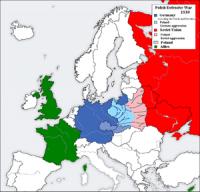Home | Military Conflict | Invasion of Poland
|
|
|
The Invasion of Poland, also known as the September Campaign or 1939 Defensive War (Polish: Kampania wrześniowa or Wojna obronna 1939 roku) in Poland and the Poland Campaign (German: Polenfeldzug) in Germany, was an invasion of Poland by Germany, the Soviet Union, and a small Slovak contingent that marked the start of World War II in Europe. The invasion began on 1 September 1939, one week after the signing of the Molotov � Ribbentrop Pact, and ended on 6 October 1939 with Germany and the Soviet Union dividing and annexing the whole of Poland. The morning after the Gleiwitz incident, German forces invaded Poland from the north, south, and west. As the Germans advanced, Polish forces withdrew from their forward bases of operation close to the Polish-German border to more established lines of defence to the east. After the mid-September Polish defeat in the Battle of the Bzura, the Germans gained an undisputed advantage. Polish forces then withdrew to the southeast where they prepared for a long defence of the Romanian Bridgehead and awaited expected support and relief from France and the United Kingdom. The two countries had pacts with Poland and had declared war on Germany on 3 September, though in the end their aid to Poland in the September campaign was very limited. The Soviet Red Army's invasion of Eastern Poland on 17 September, in accordance with a secret protocol of the Molotov � Ribbentrop Pact, rendered the Polish plan of defence obsolete. Facing a second front, the Polish government concluded the defence of the Romanian Bridgehead was no longer feasible and ordered an emergency evacuation of all troops to neutral Romania. On 6 October, following the Polish defeat at the Battle of Kock, German and Soviet forces gained full control over Poland. The success of the invasion marked the end of the Second Polish Republic, though Poland never formally surrendered. On 8 October, after an initial period of military administration, Germany directly annexed western Poland and the former Free City of Danzig and placed the remaining block of territory under the administration of the newly established General Government. The Soviet Union incorporated its newly acquired areas into its constituent Belarusian and Ukrainian republics, and immediately started a campaign of sovietization. This included staged elections, the results of which were used to legitimize the Soviet Union's annexation of eastern Poland. In the aftermath of the invasion, a collective of underground resistance organizations formed the Polish Underground State within the territory of the former Polish state. Many of the military exiles that managed to escape Poland subsequently joined the Polish Armed Forces in the West, an armed force loyal to the Polish government in exile. |




 RSS
RSS